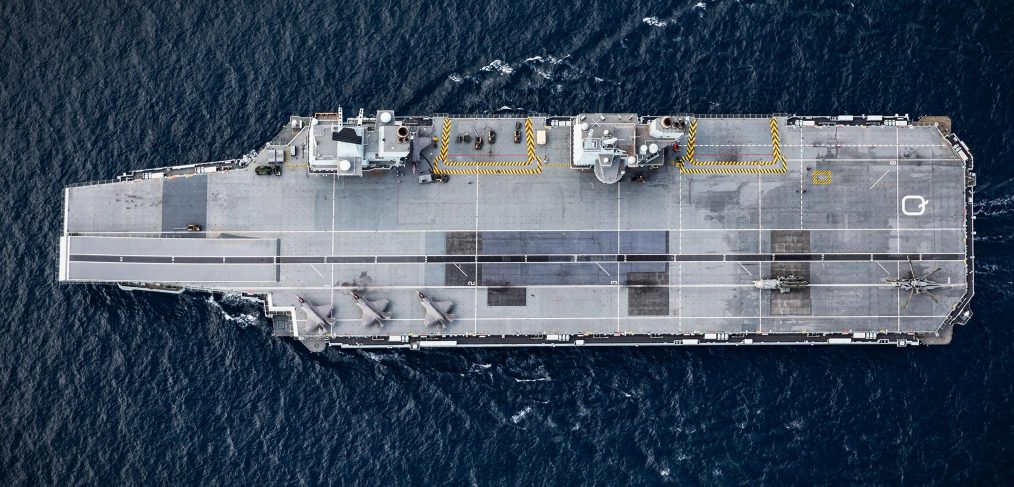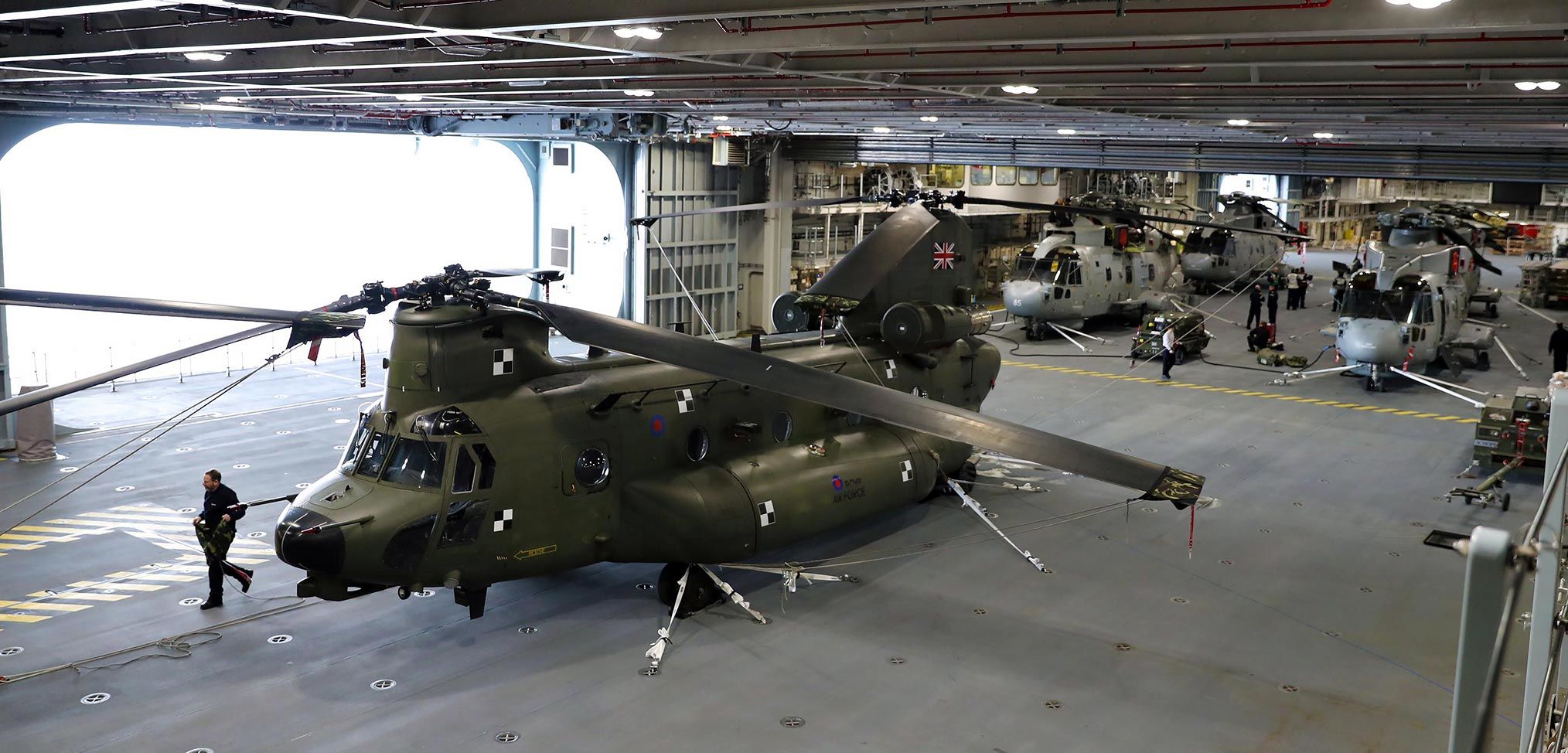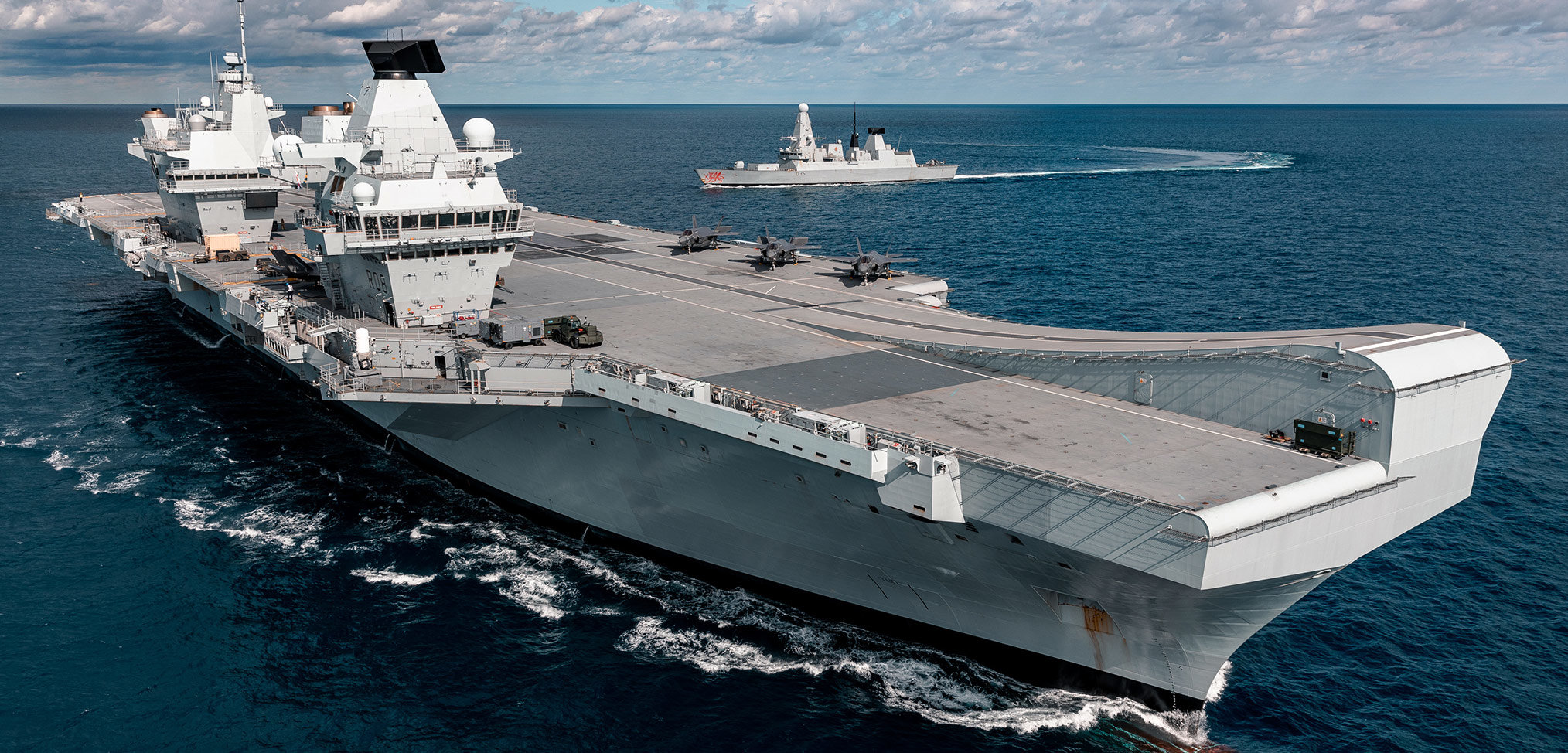
Right now there is plenty of imagery and media coverage of the Royal Navy’s aircraft carrier project. Discussion is mostly focussed on their size and design, their aircraft, their price and the politics of their construction but often a basic explanation of their function has been lacking. Here we outline the purpose and value of an aircraft carrier.
1. Cover for naval task group
Although primarily referred to as ‘strike carriers’, traditionally their first duty is to provide air cover for naval task groups. Without air superiority, both naval and merchant ships are vulnerable to aircraft and missile attack. However good ship-based air defence systems may be, they are no substitute for carrier-based fighter cover. History shows that naval fleets cannot rely on air cover from a land-based aircraft. Even if the land-based air force is dedicated to the task, it is extremely difficult to ensure the right number of aircraft in the right place to protect the fleet at all times. The RN has been devoid of its own organic fighter cover since the retirement of the Sea Harrier in 2006 and until this capability is restored, cannot be risked against foes with any kind of serious airforce. The carrier can also operate helicopters which, in co-ordination with supporting frigates, can provide anti-submarine protection. Once secure under it’s own integrated air cover and anti-submarine screen, the naval task force can then conduct any number of different missions (some of which are included below).
2. Platform to launch strikes on coastal and inland targets
The strike carrier will provide a global reach, a ‘big stick’, hard power in the support of foreign policy aims. Since more than half of the world’s population lives within 200 kilometres of the sea and the majority of the world’s largest cities are on the coast, carrier aircraft have a great ability to influence events. Carriers allow the UK to fight its enemies at arm’s length and can do much of what land-based strike aircraft do but with greater reach and flexibility.
3. Launch point for amphibious landings by troops
The carriers will have accommodation for 250 marines and could pack in a lot more troops under austere conditions for short periods. Able to land troops rapidly with embarked helicopters, the carrier can serve as a lynchpin as an amphibious operation. (Using the available QEC aircraft carrier this concept is something of a compromise and it would be preferable for the RN to have a dedicated helicopter assault ship)
4. A Flexible, mobile and responsive airbase
Experience since 1945 suggests that unpredictability is the norm for the UK’s military involvements. Almost all of the conflicts involved a naval air power dimension. Able to cover more than 500 miles in a day, a carrier can quickly reposition in response to events and threats. They can also quickly re-role, potentially flying strike missions one day and operating as a humanitarian relief hub the next.
5. Base for the delivery of humanitarian aid
Carriers are an ideal platform for the rapid delivery of humanitarian aid following natural disasters. As ‘first responders’ the helicopters can transport rescue teams, equipment, fresh water and medical supplies quickly and to inaccessible locations. The QEC carriers will always sail with some relief stores embarked but more could be rapidly loaded. The carriers themselves have a substantial onboard medical facility and teams of medical personnel. Carriers could also be used to mount an evacuation operation to rescue British citizens at risk from conflicts or natural disasters.

Their enormous capacity for people, helicopters and stores makes the carrier an ideal platform Humanitarian Aid and Disaster Relief (HADR) operations
6. A demonstration of political will without resort to force
Aircraft carriers have been and will be used to influence events without firing a shot. An aircraft carrier can ‘poise’, in international waters, perhaps not far from the coast but able to exert particular pressure and shape events without the escalation implicit in deploying soldiers on the ground or intrusions into sovereign airspace.
7. A flagship for command and control
The carriers have generous space, facilities and communications capability to operate as flagships, and a command and control hub for complex naval and military operations for sustained periods.
8. A base for intelligence gathering and reconnaissance
The carrier’s aircraft and surveillance helicopters will provide critical surveillance around a naval task group, providing early warning and assessment of threats. Carrier aircraft could also maintain a sustained watch on areas of interest ashore. Both manned an unmanned aircraft flying from the carrier have the potential to search both visually and by radar, hundreds of square miles per day.
9. Sovereign territory
Aircraft carriers avoid the constraints of complex and potentially lengthy international negotiations, agreements for the basing of aircraft on foreign soil. Operating in international waters they may also be able to circumnavigate the need to request over-flight permission from other countries. Carriers can deploy rapidly to international waters as and when government decides, unhindered by wishes of ‘host nations’. The carrier task group is also self-sustaining carrying its own logistical support with it. This avoids the major logistic effort required to move the equipment & personnel needed to support land-based aircraft.
10. A platform for trade and diplomacy, a visible symbol of prestige
HMS Queen Elizabeth has already hosted significant trade and diplomatic meetings during her visit to New York last year. Expect to see the aircraft carriers used by ministers, government officials and industry leaders to host events to promote British interests around the world. Those campaigning for a new Royal Yacht to carry out such functions might pause to consider that we now have two large modern and distinctive vessels that are ready-made for the task. Few people are likely to turn down an invitation to a reception held in the impressive surroundings of a Royal Navy aircraft carrier anchored in the harbour.
It may be unfashionable to say this with our increasingly unreal European mindset of soft power-only foreign policy, but carrier ownership gives a nation highly visible symbol of prestige and commands respect. Although some may dismiss such things as “big boys and their toys”, actually everyone in the UK benefits to some extent from living in a nation that is still a global power. Sometimes it may be for reasons of self-interest – guaranteeing our trade routes and access to resources or it may be being a force for good – keeping the peace, upholding international law or protecting allies. Carriers are a significant asset that keeps you at the ‘top table’ with a voice and influence on world events.

Possibly the most stunning image of Royal Navy warships taken in many years. The prestige and soft power value of these ships are almost as important as their more obvious fighting capabilities.
This is an updated version of an article, first published in 2014.
* In the past some naval advocates have over-stated their case and we recognise that aircraft carriers are clearly not a panacea that makes all land-based combat aircraft or bases irrelevant. Carriers cannot stay on station indefinitely, are not invulnerable or the answer to domestic terrorism and all ‘asymmetric’ threats.
This article was republished with permission from the Save the Royal Navy website, a privately run site with the aim of preventing further reductions in the UK’s naval capability by presenting informed articles about the Royal Navy’s ships and equipment, together with analysis of our national role in world affairs.

Comments on Aircraft Carriers – what are they for?